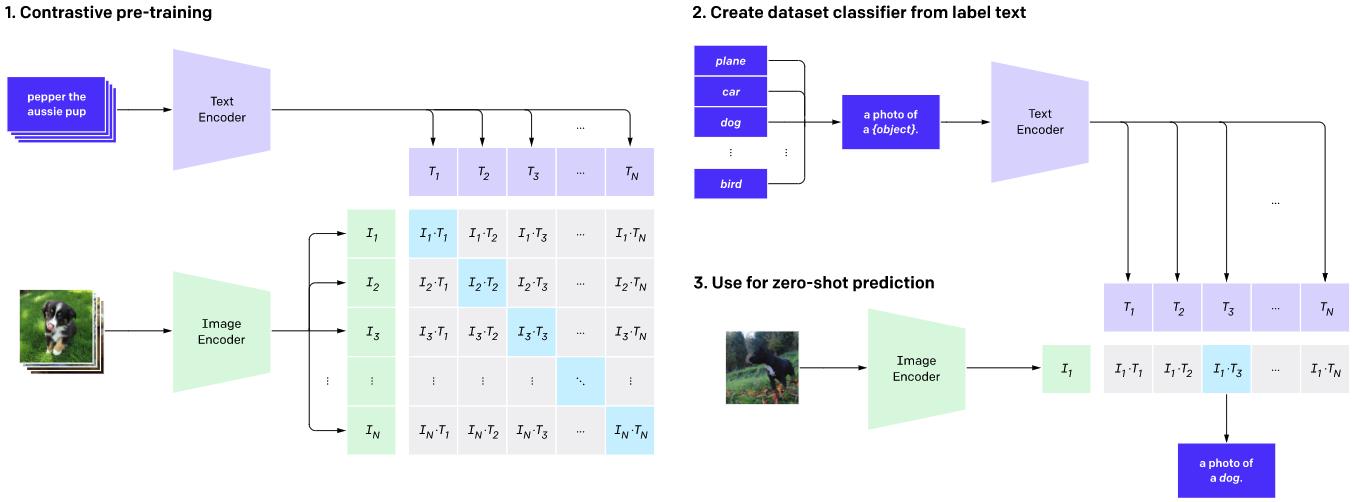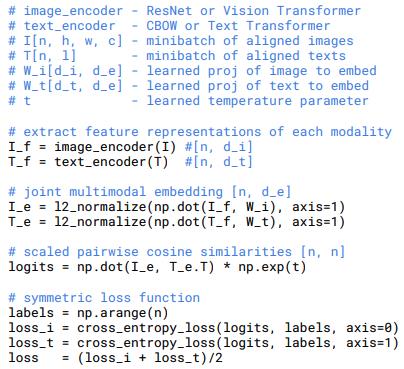CLIP算法的Loss详解 和 交叉熵CrossEntropy实现
Posted SpikeKing
tags:
篇首语:本文由小常识网(cha138.com)小编为大家整理,主要介绍了CLIP算法的Loss详解 和 交叉熵CrossEntropy实现相关的知识,希望对你有一定的参考价值。
CLIP:Contrastive Language–Image Pre-training(可对比语言-图像预训练算法)是OpenAI提出的多模态预训练的算法,在各种各样的**样本对(图像、文本)**上训练的神经网络。

其中,流程:

loss_i和loss_t的具体源码如下,参考 model.py:
def forward(self, image, text):
image_features = self.encode_image(image)
text_features = self.encode_text(text)
# normalized features
image_features = image_features / image_features.norm(dim=1, keepdim=True)
text_features = text_features / text_features.norm(dim=1, keepdim=True)
# cosine similarity as logits
logit_scale = self.logit_scale.exp()
logits_per_image = logit_scale * image_features @ text_features.t()
logits_per_text = logits_per_image.t()
# shape = [global_batch_size, global_batch_size]
return logits_per_image, logits_per_text
其中,labels是torch.arange(batch_size, device=device).long(),参考train.py,具体如下
with torch.no_grad():
for i, batch in enumerate(dataloader):
images, texts = batch
images = images.to(device=device, non_blocking=True)
texts = texts.to(device=device, non_blocking=True)
with autocast():
image_features, text_features, logit_scale = model(images, texts)
# features are accumulated in CPU tensors, otherwise GPU memory exhausted quickly
# however, system RAM is easily exceeded and compute time becomes problematic
all_image_features.append(image_features.cpu())
all_text_features.append(text_features.cpu())
logit_scale = logit_scale.mean()
logits_per_image = logit_scale * image_features @ text_features.t()
logits_per_text = logits_per_image.t()
batch_size = images.shape[0]
labels = torch.arange(batch_size, device=device).long()
total_loss = (
F.cross_entropy(logits_per_image, labels) +
F.cross_entropy(logits_per_text, labels)
) / 2
交叉熵函数:y就是label,x_softmax[i][y[i]],表示在x_softmax中筛选第i个sample的第y[i]个值,作为log的输入,全部log负向求和,再求均值。
- y所对应的就是CLIP的np.arange(n),也就是依次是第0个位置~第n-1个位置,计算log。
# 定义softmax函数
def softmax(x):
return np.exp(x) / np.sum(np.exp(x))
# 利用numpy计算
def cross_entropy_np(x, y):
x_softmax = [softmax(x[i]) for i in range(len(x))]
x_log = [np.log(x_softmax[i][y[i]]) for i in range(len(y))]
loss = - np.sum(x_log) / len(y)
return loss
# 测试逻辑
x = [[1.9269, 1.4873, 0.9007, -2.1055]]
y = [[2]]
v1 = cross_entropy_np(x, y)
print(f"v1: v1")
x = torch.unsqueeze(torch.Tensor(x), dim=0)
x = x.transpose(1, 2) # CrossEntropy输入期望: Class放在第2维,Batch放在第1维
y = torch.Tensor(y)
y = y.to(torch.long) # label的类型为long
v2 = F.cross_entropy(x, y, reduction="none")
print(f"v2: v2")
输出:
v1: 1.729491540989093
v2: tensor([[1.7295]])
参考:
以上是关于CLIP算法的Loss详解 和 交叉熵CrossEntropy实现的主要内容,如果未能解决你的问题,请参考以下文章